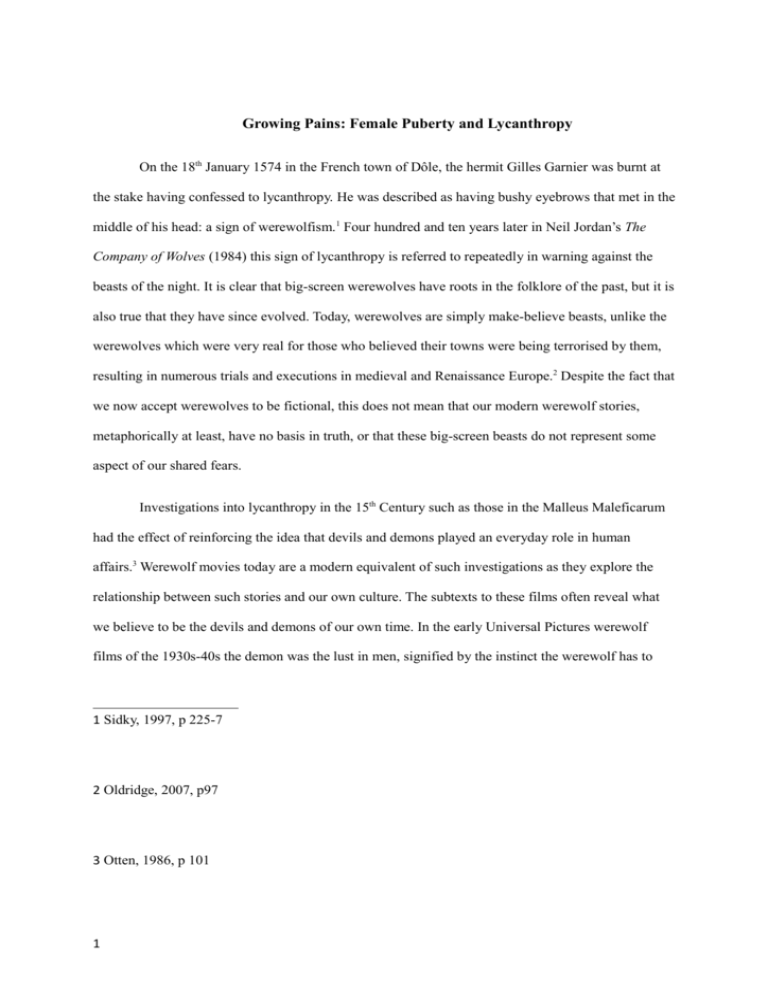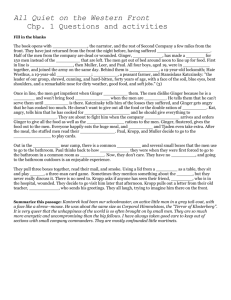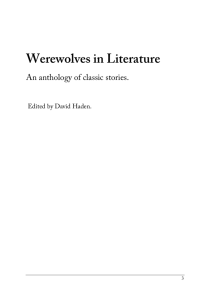
Growing Pains: Female Puberty and Lycanthropy
On the 18th January 1574 in the French town of Dôle, the hermit Gilles Garnier was burnt at
the stake having confessed to lycanthropy. He was described as having bushy eyebrows that met in the
middle of his head: a sign of werewolfism.1 Four hundred and ten years later in Neil Jordan’s The
Company of Wolves (1984) this sign of lycanthropy is referred to repeatedly in warning against the
beasts of the night. It is clear that big-screen werewolves have roots in the folklore of the past, but it is
also true that they have since evolved. Today, werewolves are simply make-believe beasts, unlike the
werewolves which were very real for those who believed their towns were being terrorised by them,
resulting in numerous trials and executions in medieval and Renaissance Europe.2 Despite the fact that
we now accept werewolves to be fictional, this does not mean that our modern werewolf stories,
metaphorically at least, have no basis in truth, or that these big-screen beasts do not represent some
aspect of our shared fears.
Investigations into lycanthropy in the 15th Century such as those in the Malleus Maleficarum
had the effect of reinforcing the idea that devils and demons played an everyday role in human
affairs.3 Werewolf movies today are a modern equivalent of such investigations as they explore the
relationship between such stories and our own culture. The subtexts to these films often reveal what
we believe to be the devils and demons of our own time. In the early Universal Pictures werewolf
films of the 1930s-40s the demon was the lust in men, signified by the instinct the werewolf has to
1 Sidky, 1997, p 225-7
2 Oldridge, 2007, p97
3 Otten, 1986, p 101
1
‘kill the thing that it loves best’.4 Often the werewolf signifies the fear of nature itself, such as in films
like The Howling (1981) and Dog Soldiers (2002), in which the principal characters are isolated in a
wilderness populated by lycanthropes. This essay will observe the evidence that exists to suggest that
werewolf films can betray a social fear of female sexuality and sexual maturity, a topic touched upon
by April Miller’s 2005 essay, "The Hair that Wasn't There Before": Demystifying Monstrosity and
Menstruation in ‘Ginger Snaps’ and ‘Ginger Snaps: Unleashed’. This fear is an inherent misogynistic
fear of allowing ourselves to be exposed to women’s issues, such as has been addressed in criticism of
film’s like Alien (1979).5 The feminine monstrous is also showcased quite clearly in Brian de Palma’s
Carrie (1976), a film which quite clearly links the developments of puberty and menstruation with the
awakening of monstrous capabilities. The film begins with Carrie’s first period and the climax comes
with her covered in blood exacting a supernatural, murderous revenge. The link between her
menstruation and the awakening of her inner demons is visually clear in this scene, and such links can
also be seen in the cases of female werewolfism in cinema.
Since the early Universal Pictures wolf movies the depictions of lycanthropes have evolved.
In modern cinema females have increasingly become victims to the curse of the werewolf. This essay
will examine some of the ways in which female werewolves are depicted using the film Ginger Snaps
(2000), in which lycanthropy serves as an analogy of puberty, as a focal point, but comparing and
contrasting some of its key aspects with other werewolf films, particularly Neil Jordan’s, The
Company of Wolves. In conducting this investigation I also hope to conclude as to what the treatment
of the she-wolves in these films suggests about attitudes to women, and deduce whether these wolves
are feminist reclamations of a cinematic archetype or negative impositions of monstrous forms and
misogynistic ideology onto women on screen.
4 Dr. Yogami (Warner Oland) in Werewolf of London (1935) 00:26:14
5 Bellin, 2005, 108-9
2
Before continuing into this debate it should be acknowledged that, though they may be avantgarde to cinema today, female werewolves were not invented by cinema. In fact, there are recordings
of female werewolves amongst earliest recorded werewolf trials.6 It is also worth noting that one of
the earliest modern werewolf fictions, The Were-wolf, written by Clarence Housman in 1896, features
a female werewolf whose beauty lulls a family into welcoming her, resulting in the deaths of three
family members. This is a highly allegorical tale in itself not only addressing, like all writers on
lycanthropy, the inner battle between good and evil, but also religious themes, and themes of the
danger to be found in women.7
In Ginger Snaps we see one of the most satisfying female werewolf transformations ever to
be realised on screen. Over a series of weeks the character of Ginger (Katharine Isabelle) undergoes a
lycanthropic metamorphosis, allowing us to observe every element of her change from the sprouting
of her tail to her full transformation into a wolf. This slow metamorphosis is unusual as the on-screen
transformation from human to wolf is usually realised within one scene. Here, the protracted
transformation is used in order to reflect the gradual changes of puberty. In other films featuring shewerewolves, often the change is short, and in a few instances such as Dog Soldiers and The Howling
the full realisation is short-lived as the character is killed almost immediately. In The Company of
Wolves the eventual transformation of the character of Rosaleen (Sarah Patterson) at the climax of the
film is not even explored - the editing simply implies it and her transformation is only confirmed by
the recognition of her necklace, now draped around the neck of her new wolf body. It is possible that
cinema’s failures to observe the female transformation fully are due to the inconvenient presence of
breasts on the female body. In any full werewolf transformation nudity necessary to display the
complete metamorphosis, and therefore it would be much more difficult to shoot such a scene with a
female werewolf without showing their breasts, which could result in an R rating, possible impacting
6 Oldridge, 2007, p103
7 Otten,1986, p.284
3
on the film’s revenue as it would be available to a narrower audience. However, I would argue that
failures to execute the full transformation on screen are evidence of the fact that filmmakers are far
more reticent about fully exploring the transformations of women into werewolves than they are about
their male counterparts. The male transformation, whether it be the simple growing of hair and slight
facial alterations of The Wolf Man and its sequels, or the violent skeletal rearrangement of David
Kessler (David Naughton) in American Werewolf in London (1981), is almost always played out on
screen. This therefore begs the question: why are we not allowed to see women turn into wolves, but
we are allowed to witness this in men?
The answer to this may be found in the subtext to Ginger Snaps, that of the changes that the
female body undergoes during puberty. In the film, Ginger is attacked by a werewolf that has been
attracted by the scent of the blood of her first period, something she and her sister refer to as ‘the
curse’. The parallels between lycanthropy mythology and the menstrual cycle are obvious. The
menstrual cycle lasts twenty-eight days, as does the cycle of the moon that controls the werewolf
when the full moon induces the transformation. Also, according to popular opinion, both women and
werewolves are subject to go crazy (in varying degrees of course) for a few days out of their cycle. In
light of the parallels between the two transformative processes, it is conceivable that many filmmakers would be uneasy in allowing the female wolf transformation to play out in full, as female
puberty is something of a cinematic grey area. Male puberty is dealt with in cinema mainly by ‘rite of
passage’ narratives of sexual conquest such as American Pie (1999), and even American Werewolf in
Paris (1997) in which teenagers promise to award each other points for ‘scoring’ with a girl. The
messier process of female puberty and the menstrual cycle is largely avoided by cinema, and on the
rare occasions that it is visited it is in such monstrous guises as that of Carrie, as discussed above. The
connection between lycanthropy and puberty is intentionally made clear in Ginger Snaps, even to the
extent of a male werewolf whose own transformative process begins with menstruation. This may
explain why the director, John Fawcett, fully visualised the female transformation into a wolf as
female transformation is the essential subject-matter of his film.
4
However, another film in which the connection between puberty and lycanthropy is evident is
The Company of Wolves. In this film the central character, Rosaleen, in her early teens, is becoming
more sexually aware, but is warned by her grandmother of men who are ‘hairy on the inside’ and turn
into wolves by night. Despite this parallel existing in the film, Rosaleen’s transformation into a wolf is
not realised on screen. The reason behind this is rooted in the different messages of the films. In The
Company of Wolves Rosaleen is comfortable with her blossoming sexuality, flirting with the stranger
she meets on the path to her grandmother’s house who is representative of the call to grow up beyond
childhood. When he is revealed to be a werewolf she submits to him, throwing the red cloak that
symbolised her sexuality on the fire and instead choosing to commit to her own sexuality, not a cloak
of sexuality that can be taken on or off.8 Thus she accepts her own sexual maturity and progresses
beyond childhood. Therefore, showing the transformation, a process which has previously been
shown in the film in the case of male transformations as horrifically violent and excruciating, would
undermine this message: that the transformation from girl into woman needn’t be painful, and for
Rosaleen it certainly isn’t a ‘curse’.
Ginger Snaps differs from this in that both Ginger and her sister Brigitte (Emily Perkins) are
both three years late menstruating, and neither are ready to accept their sexual maturity like Rosaleen.
They already possess the fear of sexual maturity that Rosaleen has avoided, and therefore the process
of puberty is particularly traumatic, as Ginger is living out a fear that both of the girls both hold.
Ginger’s transformation makes her increasingly volatile as she starts to kill remorselessly and
expresses an enjoyment of it. Her fear of the transformation of puberty is overtaken by her pleasure in
it, as it is represented analogously as lycanthropy, but unlike The Company of Wolves, the effect of
this acceptance is destructive. This demands the question: if Rosaleen’s acceptance of sexual maturity
in The Company of Wolves is a positive feminist statement about a young woman’s right to enjoy her
sexuality and her ability to cope with it, is the destructive nature of Ginger’s maturity a negative
8 Zucker, 2008, p66
5
statement, perhaps that when a girl grows up her sexual instincts cause her to be vicious and selfserving?
I would argue that this is not the case, as Ginger Snaps is also confronting Hollywood
lycanthropic conventions. Throughout Hollywood history women have usually been the victims of
werewolves and seldom gain the strength and power of a werewolf. Ginger Snaps explores how the
wolf curse would relate to a female victim. Brigitte is told by Sam (Kris Lemche), to “forget the
Hollywood rules”9 when it is established that it isn’t moonlight that powers the transformation and it
isn’t only silver bullets that kill the beast. This is also an instruction to the audience, as to see the full
and destructive force of a female wolf contradicts Hollywood werewolf conventions. Ginger says to
Brigitte, that “a girl can only be a slut, a bitch, a tease, or the virgin next door”10, in reference to the
social components of everyday life, but this is equally applicable to cinema, and in becoming a
monster she transcends the boundaries usually placed on women on screen, particularly within the
Horror genre where the woman is usually the victim and thus typically passive.11 In this way her full,
destructive transformation can be viewed as empowering in terms of the way it breaks the stereotypes
of the woman’s function on screen, and puts a female character into an active, rather than a passive
role within the narrative.
In Ginger Snaps, Ginger’s increasing acceptance of her new murderous lifestyle is
remarkable. In the instance of her first kill, that of the family dog, Ginger vomits up what she has
eaten of him and expresses disgust at her actions. However, within a few weeks following the last kill
she makes before she turns completely she expresses a profound joy in her actions: “It feels so...
9 Sam (Kris Lemche) in Ginger Snaps 00:35:16
10 Ginger (Katharine Isabelle) in Ginger Snaps 00:56:45
11 Discussed in Freeland, 1996, p744
6
good, Brigitte. It's like touching yourself.”12 In The Company of Wolves, Rosaleen accepts her
transformation, but we do not see her kill anyone. This acceptance, in both instances, differs from the
cinematic werewolf tradition as most wolf films feature people, predominantly men, trying to
overcome the curse. In the Universal Studios Wolf movies of the 1940s Larry Talbot (played by Lon
Chaney Jr.) is in search of a cure, even if that means death as he cannot bear living with his murderous
affliction. One would expect this attitude of fear, remorse or self-loathing from all lycanthropy
sufferers who have been established as favourable characters, male or female, demanding the
question; why does it seem more natural for a woman to embrace her inner wolf than a man?
To answer this, first it is necessary to establish what the acceptance of the werewolfism
suggests about the person who accepts it. On the most simplistic level it could suggest that the person
who embraces the wolf side of them already possesses some inner capability towards monstrous
behaviour. This could certainly be relevant in the case of Ginger Snaps, as the character of Ginger is a
morbid teenager who obsesses over death and suicide. It could be said that the bite of the werewolf
just unleashed her true nature. However, this does not explain why women in other werewolf films are
often more likely to accept their curse (though there are, of course, exceptions). In The Company of
Wolves, the character of Rosaleen who eventually accepts her transformation betrays no suggestion of
any internal animalistic nature waiting to be unleashed. Therefore, there must be more to say about
what the implications of the acceptance of the curse of the werewolf reflect upon the character who
accepts it. However the suggestion remains that the beast inside women, if it is not stronger than that
in men, at least rages closer to the surface of female psychology.
This inference of a more active monstrosity in females could be seen as a misogynistic
statement. The more natural acceptance of lycanthropy by women in these films could imply that
women are more naturally predisposed towards barbarity or even that women are less human to begin
with. However, I would argue that lycanthropy is analogous to sexual maturity in these films, and it is
not controversial or misogynistic that women, who experience vast physiological changes during
12 Ginger (Katharine Isabelle) in Ginger Snaps 01:13:43
7
puberty, might be instinctively more able to accept these changes. The fact that when Ginger
expresses her joy in killing she likens it to sexual pleasure reminds the audience that it is sexual
maturity, not lycanthropy that is really being played out on screen. In placing menstruation alongside
animalistic barbarity, Ginger Snaps asks the audience to judge which should be more abhorrent.
Hollywood films are much more likely to heavily feature of sex, violence and gore than teenage girls
experiencing puberty, menstruation and newfound sexual desires. The word ‘taboo’ itself may well
have etymological link to the fear of addressing menstruation, possibly coming from ‘tapua’, a
Polynesian word for menstruation.13 Here, therefore, I would conclude that the forthright way in
which Ginger Snaps brings female sexual development and menstruation onto the screen, breaking
this taboo, and the way in which it allows a female character to take on the archetypically male role of
the werewolf, gives it clear feminist value in breaking standard conventions.
Having demonstrated that Ginger Snaps is a feminist re-working of a horror archetype and
that its themes reflect issues that have been overlooked by cinema and often by society in general, it is
important to assess how effective this message has been. Ginger Snaps showcases its message within
a framework of a strong narrative, familiar character types and a good dose of blood and guts, thus
disguising its message. Many will have fully enjoyed the film without realising that they have seen a
representation of a girl’s period blood on screen, dripping down her inner thigh and encrusted into her
underwear. Menstrual blood is something almost unseen in film and the sight of it in Ginger Snaps is
shocking initially but many will not remember these images as the most vivid or disturbing in the
film.14 It might seem less shocking when compared with Brigitte eating non-menstrual human blood
off the floor and then throwing it back up, and surely the latter should be more offensive than a
process that every female goes through. Hopefully, the lesson has been learned by the public, the
MPAA and other classification bodies: a period is not offensive.
13 Miller, 2005, p 289
14 Miller, 2005, p 291
8
In conclusion, what Ginger Snaps represents is a forward-thinking movement towards
allowing female issues to be represented on screen. The film, and others like it such as The Company
of Wolves, are not clear-cut feminist statements as they do undoubtedly have some confusing elements
in representing females as remarkably adaptable to a change that cinema has already established as
monstrous. However, cinema has also previously established female characters as monstrous in their
own way, be it with the femme fatales of film noir or the passive ‘damsels in distress’ of most
westerns and other films. 15 These established female archetypes, who in their need of rescuing or
defeating put the films’ heroes in peril because they are seduced by the character’s charm and beauty,
are often nothing more than secondary problematic characters.
Furthermore, Ginger Snaps challenges these stereotypes. Though in her wolf forms she is
dangerous and vicious, she is entirely functional as a central character and drives her own narrative,
needing no male hero archetype to drive the narrative by coming to her rescue, or trying to defend or
defeat her. This, therefore, is the most important aspect of the way in which the werewolf archetype
has been used to a feminist agenda in this film. It has reclaimed the use of a genre from male
characters, and showcased the female issues of the traumatic transformations of puberty. The
implication of this need not be that all female werewolf films must address the issues of puberty to be
feminist, but this step does allow other films to go farther. Films like Ginger Snaps and The Company
of Wolves have legitimised the female werewolf on screen by living up to the violence and gore that
modern audiences have come to expect from their horror movies and allowing audiences of all
backgrounds to watch them. The genre of horror is particularly suited to tackling the issues
surrounding sexual maturity and menstruation as period blood can easily be sneaked in amongst the
blood and guts of horror. There are other ways in which cinema can exploit established archetypes
along these lines. Just as Ginger Snaps has proven that female werewolves can be equal to their male
counterparts, why then cannot women make equal cowboys, detectives, or even psychopathic serial
killers; all character types usually reserved for men. Furthermore, when placing women in these roles,
15 Hayward, 2006, p150-1 and 503
9
scriptwriters, directors and producers should not be afraid or ashamed to let their female characters
have a period if necessary.
10
Bibliography
1. Bellin, J. D., Framing Monsters: Fantasy Films and Social Alienation, 2005,
Carbondale, Southern Illinois University Press
2. Freeland, C. A., Feminist Frameworks for Horror Films¸1996, in Film Theory and
Criticism: Sixth Edition, 2004, Braudy, L., and Cohen, M. (eds), Oxford, Oxford
University Press
3. Hayward, S., Cinema Studies: The Key Concepts: Third Edition, 2006, New York,
Routledge.
4. Millar, A., ‘“The Hair that Wasn’t there Before”: Demistifying Monstrousity and
Menstruation in “Ginger Snaps” and “Ginger Snaps Unleashed”’, 2005, Western
Folklore Vol. 63 3 of 4, pp 281-303
5. Oldridge, D., Strange Histories: The Trial of the Pig, the Walking Dead, and other
Matters of Fact from the Medieval and Renaissance Worlds¸2007, New York,
Routledge.
6. Otten, C. F., (ed.), A Lycanthropy Reader: Werewolves in Western Culture, 1986, New
York, Syracuse University Press
7. Sidky, H., Witchcraft, Lycanthropy, Drugs and Disease: An anthropological study of
the European Witch-Hunts, 1997, New York, Peter Lang Publishing Inc.
8. Zucker, C., The Cinema of Neil Jordan: Dark Carnival, 2008, London, Wallflower
Press.
11
Filmography:
Alien, 1979, Riley Scott
American Pie, 1999, Paul Weitz
An American Werewolf in London, 1981, John Landis,
An American Werewolf in Paris, 1997, Anthony Waller
Carrie, 1976, Brian de Palma
The Company of Wolves, 1984, Neil Jordan
Dog Soldiers, 2002, Neil Marshall,
Ginger Snaps, 2000, John Fawcett,
The Howling, 1981, Joe Dante
Werewolf of London, 1935, Stuart Walker
The Wolf Man, 1941, George Waggner
12





